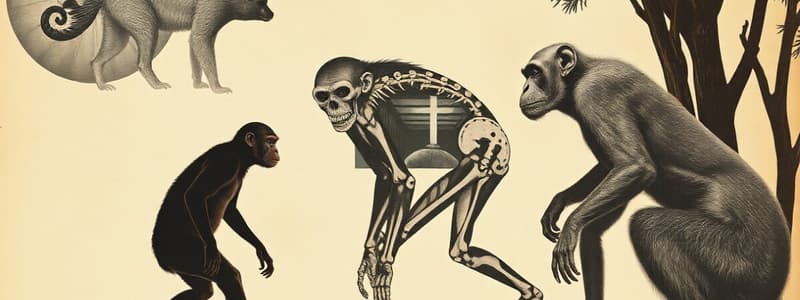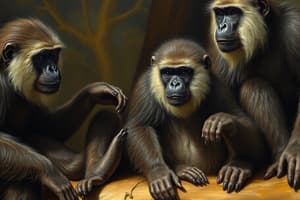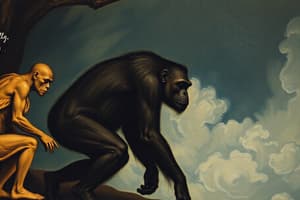Podcast
Questions and Answers
What key evidence supports the endosymbiotic theory regarding the origins of eukaryotes?
What key evidence supports the endosymbiotic theory regarding the origins of eukaryotes?
- Presence of a nucleus and linear DNA.
- The ability of eukaryotes to undergo meiosis.
- The cell membrane being made of phospholipids and proteins.
- Mitochondria and chloroplasts having their own DNA and ribosomes. (correct)
The evolution of sexual reproduction provided a significant advantage primarily by:
The evolution of sexual reproduction provided a significant advantage primarily by:
- Minimizing genetic changes in populations.
- Ensuring rapid environmental adaptation by cloning.
- Increasing the rate of cell division.
- Leading to greater genetic variation in offspring. (correct)
Which of these is a characteristic feature associated with primates, and essential for depth perception?
Which of these is a characteristic feature associated with primates, and essential for depth perception?
- Forward-facing eyes, for binocular vision. (correct)
- A prehensile tail, for grasping branches.
- A small brain size, to improve survival.
- Claws, for climbing trees.
What are major advantages of bipedal locomotion in hominids?
What are major advantages of bipedal locomotion in hominids?
Based on fossil evidence, how did hominid skulls change over time?
Based on fossil evidence, how did hominid skulls change over time?
Which of the following best describes the concept of spontaneous generation?
Which of the following best describes the concept of spontaneous generation?
What is the most widely accepted hypothesis regarding the formation of the solar system?
What is the most widely accepted hypothesis regarding the formation of the solar system?
During the Hadean Eon, which of the following was NOT a characteristic of Earth?
During the Hadean Eon, which of the following was NOT a characteristic of Earth?
The Miller-Urey experiment was significant because it demonstrated which of the following?
The Miller-Urey experiment was significant because it demonstrated which of the following?
Sidney Fox's work built upon the Miller-Urey experiment. What did Fox demonstrate?
Sidney Fox's work built upon the Miller-Urey experiment. What did Fox demonstrate?
According to the content, what is a possibility of how amino acids could have originated?
According to the content, what is a possibility of how amino acids could have originated?
What is the main concept of the 'RNA World' hypothesis mentioned in the text?
What is the main concept of the 'RNA World' hypothesis mentioned in the text?
What is the most significant contribution of cyanobacteria to the evolution of early Earth?
What is the most significant contribution of cyanobacteria to the evolution of early Earth?
What is a significant feature of mitochondria and chloroplasts that supports the endosymbiotic theory?
What is a significant feature of mitochondria and chloroplasts that supports the endosymbiotic theory?
How did sexual reproduction contribute to the evolution of complex multicellular life?
How did sexual reproduction contribute to the evolution of complex multicellular life?
Which of the following adaptations is NOT a benefit of bipedal locomotion?
Which of the following adaptations is NOT a benefit of bipedal locomotion?
Which characteristic is true of Australopithecus as compared to Homo habilis?
Which characteristic is true of Australopithecus as compared to Homo habilis?
What skeletal changes were necessary for the adaptation to bipedal locomotion?
What skeletal changes were necessary for the adaptation to bipedal locomotion?
What was the primary atmosphere composition of Earth during the Hadean Eon?
What was the primary atmosphere composition of Earth during the Hadean Eon?
Which hypothesis suggests that hydrothermal vent compartments may have housed the first living cells?
Which hypothesis suggests that hydrothermal vent compartments may have housed the first living cells?
What did the Miller-Urey experiment demonstrate about the origins of organic molecules?
What did the Miller-Urey experiment demonstrate about the origins of organic molecules?
Which type of early Earth condition allowed for the cooling and formation of distinct layers?
Which type of early Earth condition allowed for the cooling and formation of distinct layers?
What is a key feature of the RNA World Hypothesis?
What is a key feature of the RNA World Hypothesis?
What discovery was made about the meteorite found in Austria according to the Meteorite Hypothesis?
What discovery was made about the meteorite found in Austria according to the Meteorite Hypothesis?
How did cyanobacteria contribute to the early Earth's atmosphere?
How did cyanobacteria contribute to the early Earth's atmosphere?
What was significant about the amino acids formed in the Sidney Fox study?
What was significant about the amino acids formed in the Sidney Fox study?
What is the central idea behind the spontaneous generation theory?
What is the central idea behind the spontaneous generation theory?
What were the primary gases present in Earth's first atmosphere?
What were the primary gases present in Earth's first atmosphere?
What did Sidney Fox demonstrate was possible with amino acids?
What did Sidney Fox demonstrate was possible with amino acids?
What is a key characteristic of ribozymes that makes them significant in the RNA world hypothesis?
What is a key characteristic of ribozymes that makes them significant in the RNA world hypothesis?
What is the significance of the discovery about the meteorite found in Austria?
What is the significance of the discovery about the meteorite found in Austria?
What are stromatolites, and what is their importance in understanding early life?
What are stromatolites, and what is their importance in understanding early life?
According to the lipid membrane hypothesis, what is the significance of liposomes?
According to the lipid membrane hypothesis, what is the significance of liposomes?
How did the development of photosynthesis by cyanobacteria alter Earth's atmosphere?
How did the development of photosynthesis by cyanobacteria alter Earth's atmosphere?
What is the endosymbiotic theory, and which organelles are thought to have arisen through this process?
What is the endosymbiotic theory, and which organelles are thought to have arisen through this process?
Besides the ability to walk upright, what other adaptations do mammals possess that make them successful, as described in the text?
Besides the ability to walk upright, what other adaptations do mammals possess that make them successful, as described in the text?
What is significant about Homo habilis in the context of human evolution, and how does it compare to the immediately preceding group mentioned in the text?
What is significant about Homo habilis in the context of human evolution, and how does it compare to the immediately preceding group mentioned in the text?
How did the appearance of cyanobacteria impact the Earth's atmosphere and subsequent life forms?
How did the appearance of cyanobacteria impact the Earth's atmosphere and subsequent life forms?
What is the significance of the rotating shoulder joint and opposable thumbs for primates, including humans?
What is the significance of the rotating shoulder joint and opposable thumbs for primates, including humans?
The theory of ________ explains how eukaryotes evolved through one organism living inside another.
The theory of ________ explains how eukaryotes evolved through one organism living inside another.
________, the oldest primate group, were small and nocturnal.
________, the oldest primate group, were small and nocturnal.
Walking on two legs or _______, allowed hominids to have hands free for other tasks.
Walking on two legs or _______, allowed hominids to have hands free for other tasks.
The ________ group of hominids includes those with small brains and lived 3-4 million years ago in Africa.
The ________ group of hominids includes those with small brains and lived 3-4 million years ago in Africa.
The species, ________, were the first to use stone tools.
The species, ________, were the first to use stone tools.
The hypothesis that life arises from nonliving material is called ______.
The hypothesis that life arises from nonliving material is called ______.
The ______ hypothesis is the most widely accepted hypothesis for how the Earth formed.
The ______ hypothesis is the most widely accepted hypothesis for how the Earth formed.
The time on Earth between 4.6 and 3.8 billion years ago was called the ______ Eon.
The time on Earth between 4.6 and 3.8 billion years ago was called the ______ Eon.
The Miller-Urey experiment simulated early Earth conditions and created ______.
The Miller-Urey experiment simulated early Earth conditions and created ______.
The ______ hypothesis suggests that hydrothermal sea vents provided the environment for the first living cells to form.
The ______ hypothesis suggests that hydrothermal sea vents provided the environment for the first living cells to form.
According to the Lipid Membrane Hypothesis, ______ may have been the first cell membranes.
According to the Lipid Membrane Hypothesis, ______ may have been the first cell membranes.
The oldest known fossils are of ______, which added oxygen to Earth’s atmosphere.
The oldest known fossils are of ______, which added oxygen to Earth’s atmosphere.
Ribozymes in the ______ hypothesis are RNA molecules that can replicate and form proteins.
Ribozymes in the ______ hypothesis are RNA molecules that can replicate and form proteins.
Flashcards
Endosymbiotic Theory
Endosymbiotic Theory
The theory that mitochondria and chloroplasts originated from free-living bacteria that were engulfed by early eukaryotic cells.
Eukaryotes
Eukaryotes
Organisms with a membrane-bound nucleus and other organelles, such as mitochondria and chloroplasts.
Natural Selection
Natural Selection
The process by which organisms with traits better suited to their environment survive and reproduce more successfully, passing those traits on to their offspring.
Bipedalism
Bipedalism
Signup and view all the flashcards
Australopithecines
Australopithecines
Signup and view all the flashcards
Spontaneous Generation
Spontaneous Generation
Signup and view all the flashcards
Nebula Hypothesis
Nebula Hypothesis
Signup and view all the flashcards
Hadean Eon
Hadean Eon
Signup and view all the flashcards
Organic Molecule Hypothesis
Organic Molecule Hypothesis
Signup and view all the flashcards
Miller-Urey Experiment
Miller-Urey Experiment
Signup and view all the flashcards
Iron-Sulfide Bubbles Hypothesis
Iron-Sulfide Bubbles Hypothesis
Signup and view all the flashcards
Lipid Membrane Hypothesis
Lipid Membrane Hypothesis
Signup and view all the flashcards
RNA World Hypothesis
RNA World Hypothesis
Signup and view all the flashcards
Prosimians
Prosimians
Signup and view all the flashcards
What is the Nebula Hypothesis?
What is the Nebula Hypothesis?
Signup and view all the flashcards
What is the Hadean Eon?
What is the Hadean Eon?
Signup and view all the flashcards
Describe the Organic Molecule Hypothesis.
Describe the Organic Molecule Hypothesis.
Signup and view all the flashcards
What is the Miller-Urey Experiment?
What is the Miller-Urey Experiment?
Signup and view all the flashcards
What is the Iron-Sulfide Bubbles Hypothesis?
What is the Iron-Sulfide Bubbles Hypothesis?
Signup and view all the flashcards
Describe the Lipid Membrane Hypothesis.
Describe the Lipid Membrane Hypothesis.
Signup and view all the flashcards
What is the RNA World Hypothesis?
What is the RNA World Hypothesis?
Signup and view all the flashcards
What is Spontaneous Generation?
What is Spontaneous Generation?
Signup and view all the flashcards
What is a eukaryotic cell?
What is a eukaryotic cell?
Signup and view all the flashcards
Homo
Homo
Signup and view all the flashcards
Eukaryotic Cell
Eukaryotic Cell
Signup and view all the flashcards
What is the Organic Molecule Hypothesis?
What is the Organic Molecule Hypothesis?
Signup and view all the flashcards
What is the Lipid Membrane Hypothesis?
What is the Lipid Membrane Hypothesis?
Signup and view all the flashcards
Study Notes
Earliest Ideas About Life's Origin
- Creationism: Life arises suddenly and directly from a divine being.
- Spontaneous Generation: Life arises from nonliving material. This idea posited that life could appear suddenly from nonliving things.
How the Earth Formed
- Nebular Hypothesis: The most widely accepted theory. The solar system formed from a collapsing nebula of gas and dust.
- Supported by Hubble Space Telescope Data: The collapsing nebula's temperature increases due to gravitational compression as it collapses; the rotation speed increases, flattening it into a disk-shape. The sun forms at the center, and dust particles outside form planetesimals, which are several kilometers across.
Early Earth Conditions
- Hadean Eon (4.6-3.8 BYA): Earth was a molten planet frequently bombarded by asteroids and meteors.
- Initial Atmosphere: Primarily ammonia, water vapor, methane, and other simple gases.
- Oxygen Accumulation: Oxygen gradually accumulated approximately 2 billion years ago, becoming more abundant in later periods. Early earth's atmosphere lacked free oxygen.
Organic Molecule Hypotheses
- Life arose gradually from inorganic molecules.
- Building blocks like amino acids combined to make more complex polymers.
- Two Hypotheses:
- Miller-Urey Experiment: Simulated early Earth conditions to show that organic molecules (amino acids) could be made from inorganic compounds using energy from lightning.
- Meteorite Hypothesis: Amino acids may have arrived on Earth through meteorites or asteroids. A significant number of amino acids (90, including 19 naturally found on Earth) were found in a meteorite collected in 1969.
Further Experiments on Organic Molecule Formation
- Sidney Fox (1964): Built on the Miller-Urey experiment; showed that amino acids could spontaneously form small peptides under specific conditions.
Meteorite Hypothesis (1969)
- A meteorite found in Austria contained more than 90 amino acids, 19 of which occur naturally on Earth.
- Possible Interpretations: Amino acids could have been present on Earth before, formed from early Earth's materials, or arrived from meteors and asteroids.
Iron-Sulfide Bubbles Hypothesis
- Suggests hydrothermal sea vents produced sulfur compounds, which mixed with water to form compartments within rock. These compartments may have housed the first living cells, a`cting as a membrane-like structure.
Lipid Membrane Hypothesis
- Proposed that liposomes (spheres formed from phospholipids) could have created the first cell membranes, separating the internal and external environments of early cells.
RNA World Hypothesis
- Ribozymes (RNA molecules) can replicate and form proteins without the help of DNA or proteins, thus were potentially critical early in evolution.
- DNA formation requires enzymes (polymerase and helicase).
- RNA can be synthesized from inorganic compounds; however, DNA stores information more efficiently and is more stable.
Microbes Changed Earth's Conditions
- Oldest known fossils: Cyanobacteria (3.5 BYA)
- Formed Stromatolites: layered sediments trapped by cyanobacteria, providing evidence of early colonies. This process was enhanced by cyanobacteria.
- Added Oxygen: Photosynthesis by cyanobacteria added oxygen to the atmosphere, causing a significant alteration in the Earth's atmosphere. This process, called oxygenation, had many important effects including making more complex life possible.
Eukaryotes Evolved by Endosymbiosis
- Endosymbiosis: One organism living inside another.
- Lynn Margulis (1970s): First to support Endosymbiotic Theory, explaining how mitochondria and chloroplasts evolved from prokaryotic organisms through endosymbiosis.
- Evidence: Own DNA and ribosomes, circular DNA like prokaryotes, self-replication, similar size and structure to prokaryotes.
Theory of Endosymbiosis
- Diagram showing the evolution from ancestral prokaryotes to eukaryotes through the infolding of the plasma membrane and subsequent engulfment, leading to the development of the nucleus and the formation of mitochondria and chloroplasts.
The Story of Life on Earth (Timeline)
- Prokaryotic Anaerobic
- Oldest known fossils (cyanobacteria) make oxygen.
- Prokaryotic aerobic
- Eukaryotic unicellular
- Multicellular life
Sexual Reproduction's Impact
- Genetic variation is advantageous, increasing the diversity and adaptability of a species across different environments.
- Led to the evolution of complex multicellular life.
What are Primates?
- Mammals with flexible hands and feet, forward-facing eyes for depth perception, and large brains relative to their body size.
- Rotating shoulder joints and opposable thumbs.
Prosimians
- Oldest primate group (40 million years ago).
- Small and nocturnal.
Walking Upright (Bipedalism)
- Bipedal locomotion required skeletal adaptations.
- Advantages: Free hands for other activities, higher reach for foraging, carrying objects (infants, food, tools), predator avoidance, and protection of infants, improving both mobility and efficiency.
Fossils of Hominids
- Most are either Australopithecus or Homo.
- Australopithecines lived 3-4 million years ago in Africa, had small brains.
- Homo genus evolved 2.4 million years ago.
- Homo habilis: First stone tools, signifying an important step in human evolution.
- Homo neanderthalensis: Latest extinct human group.
Changes in the Human Skull Fossils
- Increased brain size in hominids over time, signifying increased cognitive ability and enhanced behavioral capabilities
- Less protruding jaw. Smaller jaw in newer hominid species, indicating evolutionary changes in the skull's structure and adapting to new food sources.
Studying That Suits You
Use AI to generate personalized quizzes and flashcards to suit your learning preferences.




